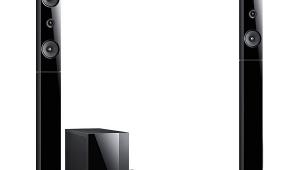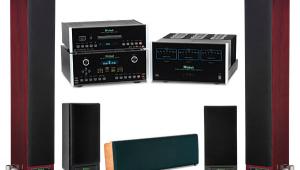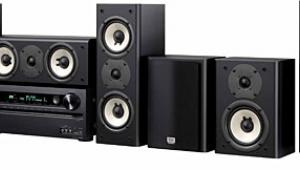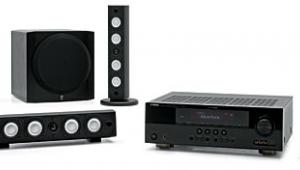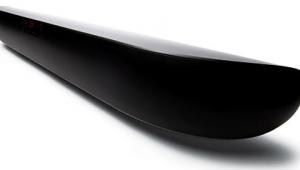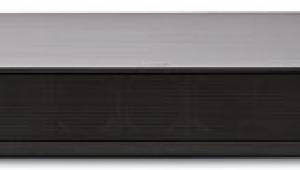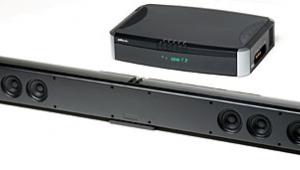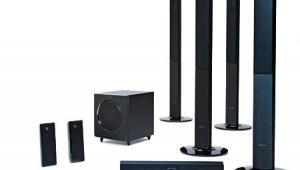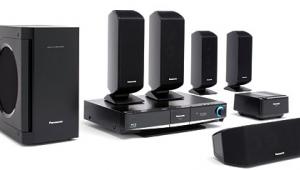Era Design 4 Speaker System, AudioControl Maestro M2 Pre/Pro, and AudioControl Savoy Amplifier
The audio industry seems about to leap off a cliff. Permit me to suggest that this may be a rash decision. True, component audio sales have diminished, but that's no excuse for the industry to abandon its principles and give up on sound quality. What consumers are rebelling against is not good sound but bad design. They've had enough of big, dumb, room-hogging speakers. "It doesn't suit the room, but it sounds good" doesn't cut it anymore. "It looks as good as it sounds" is the winning combination.

Era's Design 4 speaker system is small enough to harmonize with a space-saving video display and won't drag down a lovingly designed space. The future of high-end home theater belongs to products like this, the ones that inspire pride of ownership—the same feeling you get from a sleek flat-panel display, an iPod, a Porsche, or an Italian suit. My review samples, in a glossy blond-sycamore veneer, were the best-dressed speakers ever to visit my listening room.
Among the ways in which the Design 4 speakers defeat expectation is bass. Unlike most satellites of similar size, their midbass response reaches the 80-to-100-hertz crossover common in home theater systems. That gives your system a chance to sound more substantial. A high-end receiver might work, but it would not be overkill to run these little speakers with an outboard multichannel power amplifier like the AudioControl Savoy, mated in this Spotlight System with AudioControl's Maestro M2 surround preamp/processor.
Pre-Review Listening
Era is a company based in Bellevue, Washington, and owned by Signal Path, which also handles Musical Fidelity electronics. Four models make up the Era line. The Design 4 line includes the Design 4 monitor, with a single 4-inch woofer, and the Design 4 LCR, with two. Era also has a Design 5 line, which includes two slightly larger models with 5-inch woofers. Era's woofers are made of RF-PC, a custom-made composite of randomized fiber with a damped polymer skin. Kevlar fibers toughen up the Sub 10 subwoofer's driver. Meanwhile, Era's tweeters are Japanese-made silk domes. The price for a 5.1-channel set, with the 10-inch Sub 10, is $2,500 for the Design 4 and $3,500 for the Design 5.
While the Eras waited their turn in my review queue, I set up a pair of the Design 4 monitors on my desk with an ancient Onix 50-watt integrated stereo amp and another manufacturer's subwoofer. I used this 2.1-channel system for casual listening and, increasingly, to get a pre-review fix on the tonal balance of the satellite speakers before they moved over to my 5.1-channel reference rig. Heeding Era's instruction, I dialed in a 50-Hz crossover. The result was so gratifying that I let it run for a month.
Two things grabbed me immediately. One, of course, was the bass response. Design 4's 4-inch woofer is not just aggressive but, given enough juice, truly powerful. Letting the satellites take over a larger portion of the rhythm section at a lower crossover gave drums a brawny and well-integrated feel that made the little Onix perform almost like a muscle amp. My 2.1-channel system had never sounded so big—and this was with the same tiny sub I always use. I played a good dozen CDs by the Fall just to hear Steve Hanley's bass pounding alongside Mark E. Smith's acid-tongued vocals. One weekend turned into a Led Zeppelin festival.
Midrange was the other grabber. Although the speakers were only 2.5 feet apart, they produced a huge—and I mean huge—soundstage that leaped across the room to my armchair. It played havoc with my evening reading. Even when I sat with a book in my lap, my eyes would often stick in one spot. I'd get up and play disc after disc without turning a page for hours. The breathing of Japanese shakuhachi flutists took on vivid shape and modulation, like brightly colored tropical birds fluttering around a large greenhouse.
The sonic properties of the drivers contributed to these effects. But the crucial aspect was their interaction. Era says the tweeter is flat out to 17 kilohertz and describes it as "accurate" rather than "reticent." Even so, it was a lot less bright than nearly any other speaker I've heard in years, and that allowed the amp to pour a lot more power into the speakers before I got to the "ow, that hurts; turn it down" moment. In fact, when I did get there, it was more like "Wow, that's exhilarating but loud enough."
A Smarter Amp
The Design 4 LCR has a sensitivity rating of 87 decibels, which is on the low side of average, and the Design 4 satellites are a power-loving 84 dB. My reference receiver has enough low-frequency oomph to power even full-range speakers, but some others may not, so your best bet may be a multichannel amp like the AudioControl Savoy.
The Savoy is a Class H amplifier design. That makes it more efficient than the Class AB amps that power most receivers and multichannel amps, because it dissipates less power in the form of heat.
To perform this trick, the power supply tracks the incoming signal and varies the rail voltage for the output devices as needed. The output devices run cooler, so there is no fan, and the amp runs dead quiet even when used in an open rack (like, say, mine). It ran cooler than my disc player.
While the Savoy isn't exactly cheap, don't forget to factor in both direct and indirect energy savings. Because the amp draws less power, it wastes less power—and because it doesn't fight your air conditioning, the potential savings are even greater. Now that climate change is a real threat and power bills are skyrocketing, the Savoy increasingly defines how home theater amplification can and should work.
On the back are plastic-nut binding posts that accepted the entire length of my Monster banana plugs (a good thing—I hate it when the plugs jut out). The sensitivity switch has three settings—one for maximum noise reduction when used with the matching preamp, one for THX gear, and one for higher-gain preamps from other manufacturers. On the front, next to the power-on/standby button, is a display button that adjusts the action of the blue vertical LED power indicators.
AudioControl's Savoy amp and Maestro M2 pre/pro both offer a choice of balanced XLR connections (for long cable runs) or unbalanced RCA connections (for the rest of us). The Maestro M2 features broadcast-quality video multiplexing, 250-megahertz video passthrough, and an extensive library of commands for touchscreen interfaces.
Also based out of Washington, AudioControl has a broad range of core competencies, including wholehouse-audio products, pro analysis tools, car-audio products, and home theater products—including the famous Diva room equalizer. It's the kind of company that leavens expertise with humor. In lieu of mere manuals, the Savoy comes with a Professional Installer's Consciousness Guide, and the Maestro M2 with an Owner's Enjoyment manual. The latter's five-year warranty warns: "This is the best product we know how to build, but, if you strap it to the front bumper of your Range Rover, something will break."
It Feels Like 3 A-MMM
By the time the Era speakers and AudioControl electronics joined the suitably heavyweight Integra DPS-10.5 universal player in my rack, I came to realize that mating them was a great idea. The Savoy and Maestro M2 had a leanness that complemented the speakers' warm voluptuousness. Together, they defeated expectation in a way that brought constant delight. They were not bright, reticent, or anything in between—they abandoned that linear continuum entirely.
In its place was a combination of up-front detail and laid-back depth that made me sit up and blink. Generally, only one of those two qualities is dominant. Rarely have I heard both qualities so strongly present at the same time. It was as though someone had switched on lamps, one after another, while walking deeper and deeper into the soundstage, as the wall behind the speakers disappeared. Each voice and instrument was fully realized with texture and shadow. I started visualizing the distances of microphones from lips and guitar amps, and I wasn't trying to be clever and analytical—the amount of information coming out of familiar test tracks was simply overwhelming.
The Epics SACD from Telarc is a compilation of well-known movie soundtracks recorded in surround by Erich Kunzel and the Cincinnati Pops Orchestra. My favorite passage is the celesta-solo opening of "Hedwig's Theme" from Harry Potter and the Sorcerer's Stone. Here it was not just a charming tinkle but a glowing presence that seeped into the concert hall's acoustic environment in three dimensions. The brass fanfares of "Parade of the Charioteers" from Ben-Hur were crisp and slightly acerbic.
Smooth jazz and pop balladry are the stuff of which Najee's My Point of View is made. What made my head turn was the sophistication of the SACD release's surround mix. The surround channels are used for more than ambience, but, while I normally don't greet surround-intensive mixes with enthusiasm, here it's so adroitly rendered that it's infectious. By the time the Eras wafted the insistent chorus of Najee's "3 AM" into the back of the room—"it feels like 3 A-MMM"—I was hooked, and the effect wouldn't have been as effective if the Eras hadn't coaxed just the right velvet timbre out of Najee's seductive voice.
My curiosity about the bass angle remained. Could the Eras hack it playing full range without a sub? I ran the Dolby Digital 5.1 soundtrack of Batman Begins with and without a 50-Hz crossover. Letting the sub fill out the bottom produced the most traditionally home theater–worthy effect, as expected. But, even without the sub, the speakers pulled enough low-frequency information out of the soundtrack to keep up with the story's dramatic momentum. With string-bass lines, at such a low crossover, the sub added solidity, fullness, and roundness, but the speakers were musically intelligible by themselves.
Just in case you haven't noticed, I loved this month's Spotlight System. The amount of listening I gave the Era Design 4 speakers went way beyond the normal quota for reviewing. And, although they thrived with my various reference amps, they coaxed the most vivid textures with the AudioControl Savoy and Maestro M2. Put these products around your display and in your custom gear closet, and I think you'll agree that hi-fi, as it was once quaintly known, has come back into style. Saying consumers no longer appreciate good sound is the ultimate act of cynicism.
Highlights
Era Design 4 Speaker System:
• Small but potent satellites
• True audiophile performance
• As beautiful as speakers ever get
Highlights
AudioControl Maestro M2 Pre/Pro and Savoy Amplifier:
• Class H amp circuitry runs cool and doesn't waste watts
• Pre/pro compatible with touchscreens and other control devices
